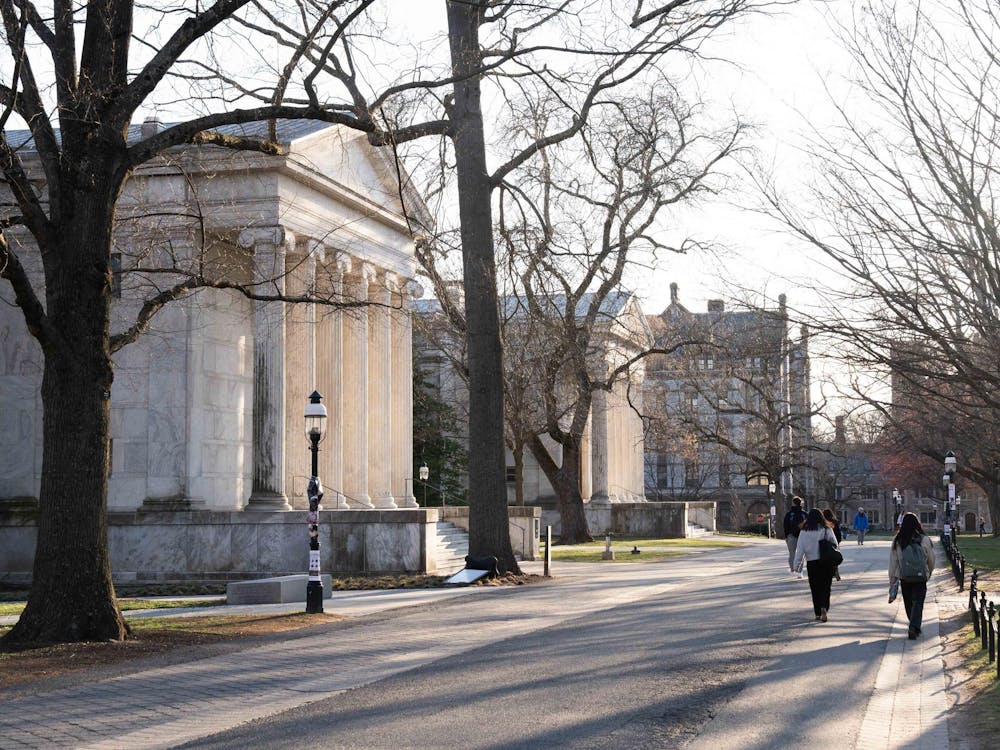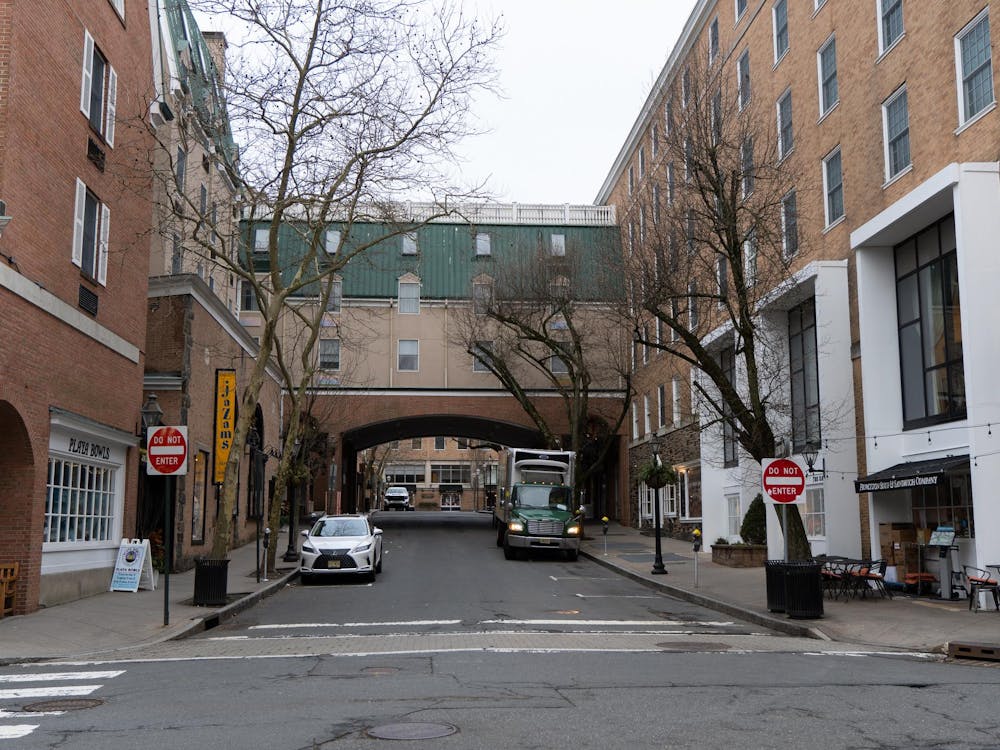Trash bags are awaiting collection outside rather than in dumpsters, starting this academic year. The dumpsters were removed to improve the aesthetics and walkability of campus, according to University sources.
The new system applies to residential and academic buildings west of Washington Road. To prepare, the University has been removing dumpsters there since July 2015, plus dumpster enclosures and cans since June 2016.
Coordinating Architect Daniel Casey said he spearheaded the project in close collaboration with the Office of the University Architect and Building Services. Facilities Civil & Environmental Engineering and the Grounds Department have been handling the construction.
“We wanted to enhance the pedestrian experience on campus and also to improve the campus landscape. The big noisy trash trucks and the dumpster enclosures were conflicting with those ideas,” Casey said, noting that discussions began in 2008.
He added that the dumpster enclosures marred courtyards and other outdoor spaces despite being shielded by concrete floors and high fences. The trucks also damaged roads and curbs while polluting the air, according to Office of Sustainability Director Shana Weber.
Casey noticed the issue as soon as he came to the University. However, without affordable alternatives, nothing changed for a long time, he said.
As he and his colleagues introduced aesthetic improvements to the walkways and landscapes, the dumpsters stood out more and more as obstacles to restoration. Casey, the head of the landscape master plan, pushed for a solution.

He drew inspiration from his 25 years living in Manhattan, where people threw trash bags into a chute in their apartment. A mini-compactor packaged the garbage several times a week, then once a week a building employee put the waste on the sidewalk to be picked up by a trash truck within an hour or two.
The approach of smaller vehicles picking up recycling and garbage around campus has succeeded on other campuses, Weber noted.
At the University, the project leaders divided campus into three zones – east of Washington Road, west of Washington Road, and north of Ivy Lane. Four or five years ago, a pilot launched in the east of Washington Road.Building Services staff collected trash using special carts, each with a device that lifted garbage cans and tipped their contents into a hopper. The workers deposited the trash at a compactor site. Having abandoned dumpsters in the first trial, Casey and his colleagues moved onto zone two, which included the academic and residential buildings west of Washington Road.
They started building a waste transfer station to serve as the sole contact point in zone two at the southern tip for garbage trucks.

Meanwhile, members identified 16 dumpster sites that intruded on the environment.
“What can we do to collect garbage [in] a different way so that we can maybe use smaller vehicles, take it to a central place instead of having these big blots on the landscape all over?” Casey said they asked themselves.
A transition program from July 2015 onward featured Building Services replacing the dumpsters with 96-gallon blue garbage cans to be collected by carts, which carried the contents to garbage trucks waiting in Lot 20.
In March 2016, the Office of Design and Construction finished installing a compactor pad at the waste transfer station. Four compactors became operational by late May. Right after graduation in June, staff started removing dumpster enclosures and cans, as well as restoring dumpster sites, to make trash bags directly collectible.
Casey noted that the garbage trucks need not even enter campus anymore. Instead, they collect garbage from the waste transfer station at the outskirts about once a week, sparing the community from odors and noise.
Ideally, Casey said, the trash bags in zone two would stay outside for only one hour in the early morning before pickup by Building Services. He identified janitors as responsible for placing the bags outside at the appropriate time.
However, Logan Sander ’18, president of the International Food Co-op in Laughlin Hall, said student groups often put waste outside toward the end of the day before sunset, when many pedestrians can see the bags.
“We have to take the trash out in the afternoon by ourselves, so it has to sit out there for a while. But I guess around most of the areas that don’t have a place like a co-op, it would make it look better because we don’t have dumpsters, and they drive the trash away every morning,” she said.
For example, in her dormitory, 1901 Hall, students place their waste bins in the halls every day, then the custodians move the bags to the courtyard just minutes before a cart removes the pile.
Nevertheless, she remained skeptical. “Is a pile of trash bags really more appealing than having a dumpster?”
Casey said that to his knowledge, not much information about the switch had reached the public. Sander found administrators’ failure to communicate about the new system strange.
“They didn’t tell us anything about how to get rid of the trash or what to do about it. We just noticed there wasn’t a dumpster there,” she said.
When she called Facilities, an employee told her the University had decided to remove dumpsters because they were an eyesore. She received white bags for trash and blue bags for recycling.
Building Services Director Regan Winston explained that as of last week, every building is using the color distinction so that passersby know the University is treating recyclables differently from trash.
“Obviously we can only control so much, if at all, of what people put into these containers,” Winston said. He added that another office will devise a way to inform the University community that if at all contaminated, an item must go into the white rather than blue bags.
Other students said they had never heard of the new trash collection system.
Scully Hall dorm assistant Vanessa Smith ’17 did notice a huge pile of trash bags while walking around Rockefeller and Mathey Colleges this year, but without any context thought it might be laundry.
She said that there were downsides to the previous arrangement.
“I found the dumpsters to be incredibly unsightly during move-in and also during big going out weekends, like homecoming or Lawnparties and stuff like that … where there was a lot of trash, I felt like it wasn’t taken care of well,” she said, attributing the issue to students more so than the administration.
However, she disapproved of the dumpster removal project.
“If you just have trash out until it gets picked up at whatever point, that leaves it vulnerable for reckless drunk students, rodents, and things like that … I’d rather have smelly, ugly bins than raccoons walking me home at night,” she said, noting she has seen more raccoons in the past three weeks than in her past three years at the University.
Trash bags sitting outside for a couple of hours should pose no problems, even if they contain food from several days earlier. If left overnight, the bags could attract raccoons and other creatures, but the schedule precludes that situation, Weber said.
Winston said Building Services had received no complaints about animals as of Wednesday.
“We haven’t really communicated or developed plans to communicate to the community on how we’re going to address the issue with rodents or any kinds of other animals getting into the trash. If that starts happening, we’re going to have to change something,” Winston said.
Brown Hall dormitory assistant Selam Zenebe-Gete ’18 said she had not perceived any change in the number of dumpsters or trash bags on campus. She preferred dumpsters to trash bags, though the choice mattered little to her, she added.
She explained that she expected the change to affect maintenance workers more than anyone else.
“People are probably going to keep doing what's most convenient for their schedules when it comes to trash disposal and collection,” Zenebe-Gete said.
She noted that students typically have other priorities.
Smith predicted that students would be too irresponsible to put their trash outside. Many of the 300 residents she oversees do not even put their trash in the hall, she added.
Weber said she is curious about how the community can take advantage of such changes to establish a more sustainable culture. She said she would love to survey students about whether seeing trash bags outside increases their awareness of their personal choices or frustrates them.
Weber noted that recycling and trash patterns in dormitories and office buildings form a small slice of the University's waste output, but are the easiest to influence via programming.
“You have to make sure the staff are trained in how the program works behind the scenes, but then you also have to train the users of the bins. How do you do that effectively?” she asked.
To find out if the elimination of garbage trucks moving through campus produces a smaller carbon footprint despite the increase in the number of carts, the Office of Sustainability would need to conduct tests, Weber added.
“We're constantly investigating…‘Given the options we have, what's the best choice if we want to be responsible from a sustainability perspective?’ Oftentimes we run into these questions where the answer isn't immediately obvious, and that can turn into a really terrific student project, or an analysis project within the Office of Sustainability, or with another partner on campus,” she explained.
Winston said that he perhaps would not have instituted the dumpster removal project, but was giving it a chance. He noted that since he just started his job in August, he must observe the changes his predecessors implemented before trying to change them.
He praised the program for beautifying campus and eliminating trash trucks. On the downside, he noted that it costs Building Services more time and labor, though such challenges may well be resolved.
Winston explained that Dillon Gymnasium staff already complained about the trash bags around the building when it opened at 6:30 a.m. and at events after hours. Building Services reacted by adding 96-gallon trash cans to a hidden spot in the area, a solution that might extend to other facilities if needed.
Winston said that while it was too early to tell how the project would evolve, he felt at some point administrators might need to revisit the project. They may not necessarily return the dumpsters, but could revamp the plan to address concerns.
“We'll just keep an open mind and tackle the issues as they come, if they come,” Winston said, noting that he is hoping for the best.
According to Casey, buildings with loading docks, like Firestone Library and Frist Campus Center, will retain their dumpsters because they conceal garbage trucks. However, all other dumpsters in zone two will disappear. He said the team had hoped to finish removal this fall, but fell behind due to a high volume of summer projects.
Casey said restoration in zone two will continue this fall and winter. Zone three will probably rely on the existing compactors in the Engineering Quadrangle and zone one.
He anticipated that in a possibly subtle way, the dumpster removal project would bring big improvements to life on campus.







